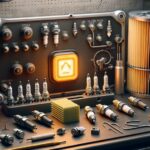
Understanding Your Check Engine Light: Common Causes and Solutions
July 3, 2024
Top Diagnostic Tools for Accurate Engine Troubleshooting
July 3, 2024In the realm of automotive diagnostics, mastering the interpretation of OBD-II (On-Board Diagnostics II) codes is essential for pinpointing and resolving vehicular issues efficiently. These codes, generated by the vehicle’s onboard computer system, are pivotal in identifying the root causes of engine and performance problems. A common misconception is that the code directly reveals the malfunction; however, it primarily indicates the affected system or sensor, requiring further investigation using specific diagnostic tools. As we explore the nuances of these codes, understanding their structure and the strategic application of advanced diagnostic equipment will be crucial for anyone looking to enhance their technical prowess in automotive troubleshooting. What remains to be seen is how these diagnostics can be streamlined to reduce error and auto repair efficiency.
Understanding OBD-II Codes
OBD-II codes, integral to an automotive diagnostic system, provide essential insights into the vehicle’s engine and related systems by identifying specific errors and malfunctions. These codes, standardized across the automotive industry, are critical for ensuring that vehicles operate efficiently and safely.
Understanding these codes is essential for both professionals and enthusiasts within the automotive community. Each OBD-II code consists of a five-character alphanumeric sequence that indicates the nature and location of a fault. The first character, a letter, identifies the system related to the issue: ‘P’ for Powertrain, ‘B’ for Body, ‘C’ for Chassis, and ‘U’ for Undefined. The second character, a number, differentiates between manufacturer-specific (1) and generic (0) codes. The last three digits pinpoint the exact malfunction, varying from emissions failures to sensor faults.
These codes empower vehicle owners and technicians by providing a starting point for diagnostics, fostering a sense of inclusion and technical empowerment within the community.
Diagnostic Tools and Techniques
To effectively troubleshoot and decode OBD-II error messages, automotive professionals employ a range of diagnostic tools and techniques. Central to these tools is the OBD-II scanner, a crucial device that interfaces with a car’s computer system to retrieve diagnostic codes. This device not only reads codes but also provides real-time data monitoring, which helps in pinpointing exact issues.
Advanced scanners come equipped with features like freeze frame data, which captures the engine’s condition at the time of an error, allowing for a more detailed analysis. Moreover, bi-directional control capability in some high-end models enables the user to test various systems actively by sending commands to the vehicle’s OBD system, simulating and monitoring operational responses.
Beyond scanners
Professionals often use oscilloscopes to observe the electrical waveforms of sensors and actuators. This technique is indispensable for diagnosing intermittent issues that might not set a permanent DTC (Diagnostic Trouble Code).
Similarly, a multimeter measures voltage, resistance, and current, essential for verifying the integrity of circuits and components.
As part of an inclusive community of diagnostic experts, embracing these sophisticated tools and techniques not only enhances skill sets but also fosters a deeper understanding of automotive systems, ensuring high-quality service and auto repair.
In the realm of automotive diagnostics, mastering the interpretation of OBD-II codes is akin to deciphering an intricate map that leads to the treasure of optimal vehicle performance. Equipped with the right diagnostic tools and a firm grasp of the code structure, the mechanic navigates through the labyrinth of data, uncovering faults and restoring functionality.
Thus, the journey from code retrieval to problem resolution becomes a testament to the blend of technical acuity and practical application.
Next article Prev article



